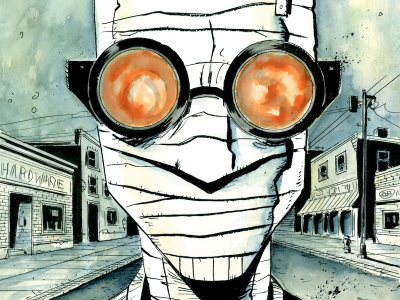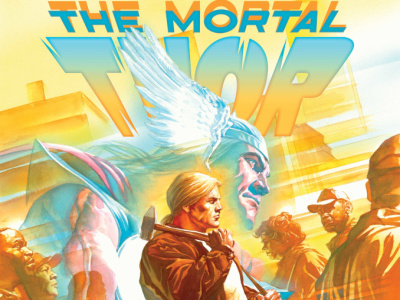Sharpening the Sword is a regular column by retailer John Riley of Grasshopper's Comics, a 1300 square foot comic and games store in
I'd like to respond to Dean Phillips' of Krypton Comics remarks about back issues, a discussion I started here a while back. First of all, having perused his Web site, it's clear that Krypton Comics is a huge, well run store with a wide range of events, and clearly very devoted to comics. Dean apparently does very well with back issues, and he should be commended for it, but I don't think that his remarks were really in contradiction to what I was originally discussing regarding back issues in the current retail environment. In fact, I think the fact that his store does so well with back issues supports my argument. Because my argument was not that stores should stop carrying back issues, but rather that stores should stop blindly carrying back issues and consider what is truly best for their store's health with regard to this category.
To illustrate this I'd like to look at two different stores, both of which are real locations.
Store A is a friend's place located in the
Store B is located in the suburbs just outside a major city. Store B is a little larger at almost 8,000 square feet, but with no parking. Store B's rent is...wait for it...$33,000 a month plus taxes of $7,000 a month, for a total cost of $40,000 a month. Store B has a massive population density, but also has much higher utility, insurance, and advertising rates.
My initial argument is that these two businesses simply cannot ever hope to function in the same manner regarding back issues and still make the rent. Here's how I would assume each store would treat the category.
Store A has very inexpensive space but a low population density, meaning they need to attract customers from a much larger area to see significant sales. With this in mind I would expect that Store A could easily specialize in back issues, perhaps stocking hundreds of thousands of books. Although the category will still have a low turn rate, since the space is so inexpensive this isn't really an issue. The huge inventory of back issues can also be a large draw for customers to travel from other areas (and other stores). And of course, once the customers are there they are apt to buy other things as well. With such inexpensive space, I would expect that Store A could actually do this with a number of categories, building up a truly impressive inventory in each category and attracting people from a much larger area than they could with simply the standard new comics.
But it would be suicide for Store B to operate that way. Obviously, their overhead just isn't going to get paid devoting 50% of their floor space or more to back issues (and let's face it, having a decent back issue selection requires a significant investment in floor space regardless of the efficiency of fixtures.) Store B has to perform a balancing act. Since the majority of their sales would probably come from new comics and trade paperbacks, both of which can be displayed relatively space-efficiently, would it make sense to use that expensive space for back issues that have a low turn rate or other categories that might turn better? Since Store B has a much higher population density they don't have to work so hard at drawing from outside their area, but might be better off simply trying to satisfy every potential customer in their area. That might mean a much more diverse inventory mix with a more limited back issue presence.
Traditionally, going all the way back to shops I frequented in the early 1970s, comic shops have been set up with periodicals/comics along the wall and rows of back issue bins in the middle. My argument was that in some cases, this model just doesn't work anymore. If Store B was set up that way, it's easy to assume that $35,000 of their monthly expenses would be just for square footage devoted to back issues, a number that I don't think would work well for anyone. And remember, these examples are real numbers from real businesses.
I initially proposed that back issues can now be considered an area of specialization. From what Dean wrote, their back issues are very strong partly because other stores in his market don't support the category as extensively as he does. But here's a question: If every store in Krypton Comics' market stocked back issues the same way they did would he be seeing the same level of sales? Would he be seeing customers coming from other stores? If the other four stores in his area all stocked like him and his back issue sales fell by say 50%, would he still be happy with the return on that space?
Krypton chooses to specialize in back issues as a competitive advantage and apparently that's a great decision for them, but it might not work for everyone. For some, that area of specialization might be in manga, or trade paperbacks, or action figures, or garage kits, or statues, or any combination of ancillary products that stores can choose to specialize in. Each store needs to consider what its financial/space constraints are, what its market demographics look like, what its competition is doing, and what product mix would be optimal. That mix may include hundreds of thousands of back issues, or maybe it won't include any at all.
It's been a few months now since we stopped carrying back issues in the traditional way. As I said previously, we now no longer have back issue bins, but rather keep the last twelve to eighteen months or so worth of books for currently ongoing series on display. The results? Our new issue sales are up thanks to all the room we gained, and our sales of recent back issues (which was the overwhelming majority of our "back issue" sales previously) are up as well since they're out of the bins and on display. It's a solution that seems to be working for us. I wouldn't recommend it for everyone, but for us at least it seems to make sense.
The opinions expressed in this Talk Back article are solely those of the writer, and do not necessarily reflect the views of the editorial staff of ICv2.com.







